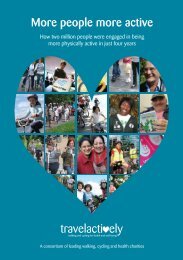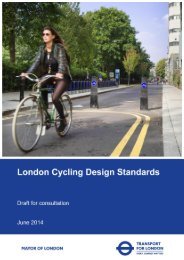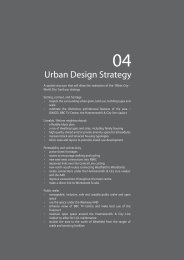Travel in London Travel in London
travel-in-london-report-8
travel-in-london-report-8
You also want an ePaper? Increase the reach of your titles
YUMPU automatically turns print PDFs into web optimized ePapers that Google loves.
3. <strong>Travel</strong> trends by mode<br />
Figure 3.12<br />
Trend <strong>in</strong> monthly cycle hires by type of hire.<br />
1,400<br />
1,200<br />
Open to<br />
casual users<br />
December 2010<br />
Eastern<br />
extension<br />
March 2012<br />
Southwest<br />
extension<br />
December 2013<br />
Number of hires (thousands)<br />
1,000<br />
800<br />
600<br />
400<br />
200<br />
0<br />
Source: TfL Surface Transport, Outcomes, Insight and Analysis.<br />
3.12 Modal trends: Walk<strong>in</strong>g<br />
Some 6.4 million walk-all-the-way trips were made on an average day <strong>in</strong> <strong>London</strong> <strong>in</strong><br />
2014. This is an <strong>in</strong>crease of 9.3 per cent s<strong>in</strong>ce 2008, this <strong>in</strong>crease ma<strong>in</strong>ly reflect<strong>in</strong>g<br />
population growth over the period (which was also 9.3 per cent). This gives a<br />
walk<strong>in</strong>g mode share (for all travel) of 21 per cent, which is identical to the position<br />
<strong>in</strong> 2008. However, there is evidence that <strong>in</strong>creased public transport use has, as a<br />
by-product, <strong>in</strong>creased the number of walk journey stages undertaken by <strong>London</strong>ers,<br />
with associated health benefits. Section 11.8 of this report considers the<br />
characteristics of walk<strong>in</strong>g <strong>in</strong> <strong>London</strong>, while section 9.7 looks at the contribution of<br />
walk<strong>in</strong>g to active travel <strong>in</strong> <strong>London</strong>.<br />
3.13 Modal trends: Road-based freight and servic<strong>in</strong>g<br />
Road is by far the dom<strong>in</strong>ant mode for goods transport <strong>in</strong> <strong>London</strong> <strong>in</strong> terms of the<br />
weight of goods lifted. This section looks at trends <strong>in</strong> the volumes of road freight<br />
vehicles, <strong>in</strong> terms of vans and heavy goods vehicles. It uses two ma<strong>in</strong> sources of<br />
data – cordon cross<strong>in</strong>g data from TfL’s surveys and area-based volumetric data<br />
from DfT’s traffic counts.<br />
Vans<br />
Figure 3.13 shows the trend <strong>in</strong> light goods vehicle traffic (vehicle kilometres) <strong>in</strong><br />
central, <strong>in</strong>ner, outer and greater <strong>London</strong>. Figure 3.14 is the equivalent trend <strong>in</strong> the<br />
volume of light goods vehicles cross<strong>in</strong>g the central, <strong>in</strong>ner and boundary cordons,<br />
correspond<strong>in</strong>g to central <strong>London</strong>, <strong>in</strong>ner <strong>London</strong> and the GLA boundary respectively.<br />
Note that the count<strong>in</strong>g cordons relate to a specific set of locations, which are<br />
optimised to measure radial traffic movements. They therefore may not be<br />
representative of overall traffic trends or levels.<br />
65 <strong>Travel</strong> <strong>in</strong> <strong>London</strong>, Report 8








